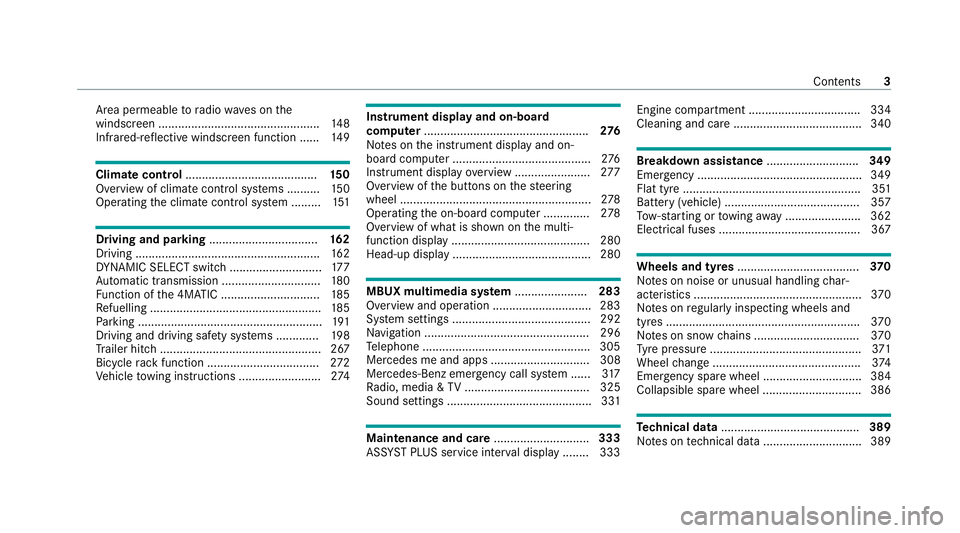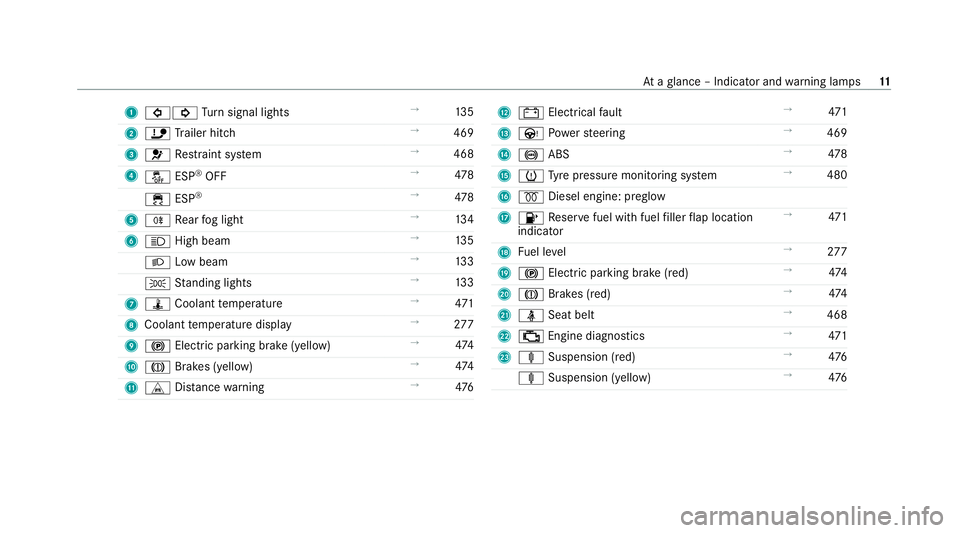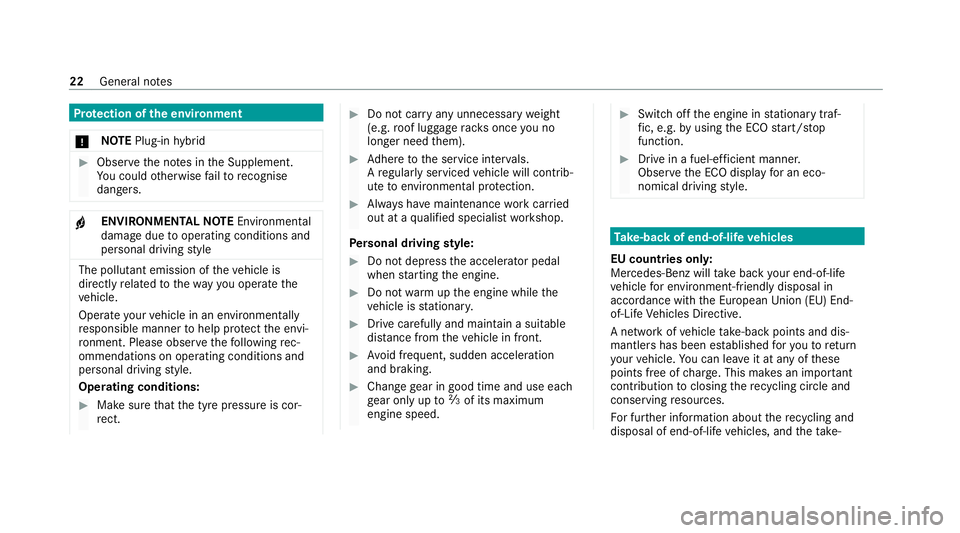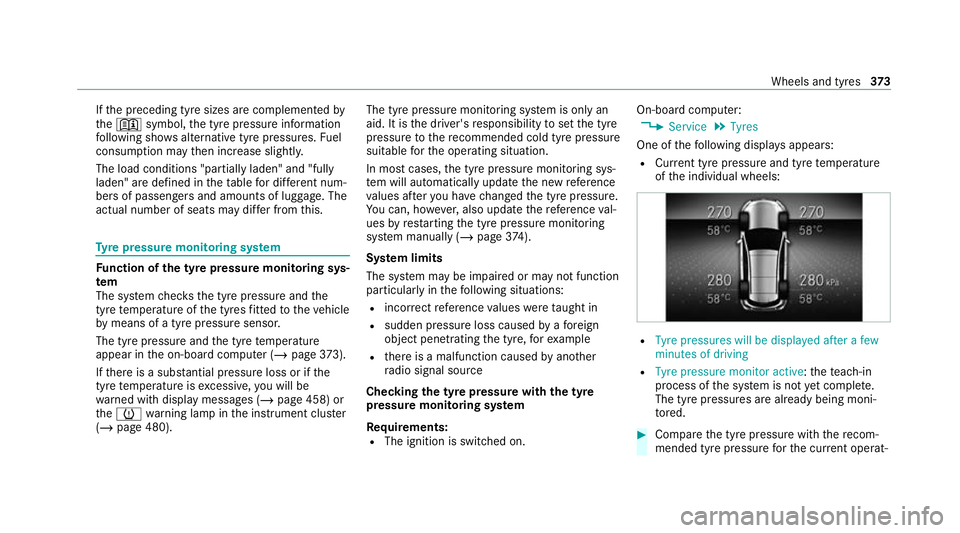2021 MERCEDES-BENZ GLE COUPE fuel pressure
[x] Cancel search: fuel pressurePage 6 of 525

Area pe
rmeable toradio wav es on the
windscreen ................................................ .148
Infrared-reflective windscreen function ...... 14 9Climate control
........................................ 15 0
Overview of climate contro l systems ..........1 50
Operating the climate control sy stem ......... 151 Driving and pa
rking ................................. 16 2
Driving ........................................................ 16 2
DY NA MIC SELECT switch ............................1 77
Au tomatic transmission .............................. 180
Fu nction of the 4MATIC .............................. 185
Re fuelling .................................................... 185
Pa rking ........................................................ 191
Driving and driving sa fety sy stems .............1 98
Tr ailer hit ch................................................. 267
Bicycle rack function .................................. 272
Ve hicle towing instructions ........................ .274 Instrument display and on-board
compu
ter.................................................. 276
No tes on the instrument display and on-
board computer .......................................... 276
Instrument display overview ...................... .277
Overview of the buttons on thesteering
wheel ..........................................................2 78
Operating the on-board computer .............. 278
Overview of what is shown on the multi‐
function display .......................................... 280
Head-up display .......................................... 280 MBUX multimedia sy
stem ...................... 283
Overview and operation .............................. 283
Sy stem settings .......................................... 292
Na vigation .................................................. 296
Te lephone .................................................. .305
Mercedes me and apps .............................. 308
Mercedes-Benz emer gency call sy stem ...... 317
Ra dio, media & TV...................................... 325
Sound settings ............................................ 331 Main
tenance and care ............................. 333
ASS YST PLUS service inter val display ........ 333 Engine compartment .................................. 334
Cleaning and care ......................................
.340 Breakdown assi
stance ............................ 349
Emergency ................................................. .349
Flat tyre ...................................................... 351
Battery (vehicle) ......................................... 357
To w- starting or towing away ....................... 362
Electrical fuses ........................................... 367 Wheels and tyres
..................................... 37 0
No tes on noise or unusual handling char‐
acteristics .................................................. .370
No tes on regular lyinspecting wheels and
tyres .......................................................... .370
No tes on snow chains ................................ 370
Ty re pressure .............................................. 371
Wheel change ............................................ .374
Emergency spare wheel .............................. 384
Collapsible spare wheel .............................. 386 Te
ch nical data .......................................... 389
No tes on tech nical da ta.............................. 389 Contents
3
Page 14 of 525

1
003E003D Turn signal lights →
13 5
2 ï Trailer hit ch →
469
3 0075 Restra int sy stem →
468
4 00BB ESP®
OFF →
478
00E5 ESP®
→
478
5 005E Rear fog light →
13 4
6 0057 High beam →
13 5
0058 Low beam →
13 3
0060 Standing lights →
13 3
7 ÿ Coolant temp erature →
471
8 Coolant temp erature display →
277
9 0024 Electric pa rking brake (yellow) →
474
A 004D Brakes (yellow) →
474
B L Distance warning →
476 C
003D Electrical fault →
471
D Ù Powe rst eering →
469
E 0025 ABS →
478
F 0077 Tyre pressure monitoring sy stem →
480
G 0028 Diesel engine: preglow
H 00B6 Reser vefuel with fuel filler flap location
indicator →
471
I Fuel le vel →
277
J 0024 Electric pa rking brake (red) →
474
K 004D Brakes (red) →
474
L 00E9 Seat belt →
468
M 00B9 Engine diagnostics →
471
N ä Suspension (red) →
476
ä Suspension (yellow) →
476 At
aglance – Indicator and warning lamps 11
Page 22 of 525

1
B-pillar with:
QR code for accessing there scue card →
35
2 Safetyve sts →
349
3 Fire extinguisher →
350
4 ; me button →
310
0053 SOS button →
310
5 Tocheck and top up operating fluids →
393
St arting assis tance →
361
6 Tow- starting or towing away →
363
7 Flat tyre →
351 8
002F Hazard warning light sy stem →
13 5
9 Fuelfiller flap with:
information label on fuel type →
185
information label on tyre pressure →
372
QR code for accessing there scue card →
35
A Tow- starting or towing away →
363
B Warning triangle →
349
C First-aid kit (so ftsided) →
350
D TIREFIT kit →
353 At
aglance – Emer gencies and breakdowns 19
Page 25 of 525

Pr
otection of the environment
* NO
TEPlug-in hybrid #
Obser vethe no tes in the Supplement.
Yo u could otherwise failto recognise
dangers. +
ENVI
RONMENTAL NOTEEnvironmental
dama gedue tooperating conditions and
personal driving style The pollutant emission of
theve hicle is
directly related tothewa yyo u operate the
ve hicle.
Operate your vehicle in an environmentally
re sponsible manner tohelp pr otect the envi‐
ro nment. Please obser vethefo llowing rec‐
ommendations on ope rating conditions and
pe rsonal driving style.
Operating conditions: #
Make sure that the tyre pressure is cor‐
re ct. #
Do not car ryany unnecessary weight
(e.g. roof luggage rack s once you no
lon ger need them). #
Adhere tothe service inter vals.
A regularly serviced vehicle will contri b‐
ute toenvironmen tal pr otection. #
Alw ays ha vemaintenance workcar ried
out at a qualified specialist workshop.
Pe rsonal driving style: #
Do not depress the accelera tor pedal
when starting the engine. #
Do not warm upthe engine while the
ve hicle is stationar y. #
Drive carefully and maintain a suitable
dist ance from theve hicle in front. #
Avoid frequent, sudden acceleration
and braking. #
Change gear in good time and use each
ge ar on lyup to00C3 of its maximum
engine speed. #
Switch off the engine in stationary traf‐
fi c, e.g. byusing the ECO start/ stop
function. #
Drive in a fuel-ef ficient manne r.
Obser vethe ECO display for an eco‐
nomical driving style. Ta
ke -back of end-of-life vehicles
EU countries onl y:
Mercedes-Benz will take back your end-of-life
ve hicle for environment-friendly disposal in
accordance with the European Union(EU) End-
of-Life Vehicles Directive.
A network of vehicle take -ba ckpoints and dis‐
mantlers has been es tablished foryo uto return
yo ur vehicle. You can lea veit at any of these
points free of charge . This makes an impor tant
contribution toclosing there cycling circle and
conse rving resources.
Fo r fur ther information about there cycling and
disposal of end-of-life vehicles, and theta ke- 22
General no tes
Page 187 of 525

#
Activating: Pullsteering wheel gearshift
paddle 1or2.
Manual shifting is activated for a short time.
Tr ansmission position 0063and the cur rent
ge ar appear in the multifunction displa y.#
Deactivating: Pullsteering wheel gearshift
paddle 2and hold it in place.
The transmission position 005Bappears in the
multifunction displa y.
% Topermanently shift thege ars manually in
drive prog ram = using thesteering wheel
ge arshift paddles, select the0063 setting for
th e transmission.
Shifting #
Shifting up: Pullsteering wheel gearshift
paddle 2. #
Shifting down: Pullsteering wheel gearshift
paddle 1. Gea
rshift recommendation The
gearshift recommendation assists you in
adopting an economical driving style. #
Ifth ege arshift recommendation 1appea rs
next tothe transmission position displa y,
shift tothere commended gear. Using kickd
own #
Maximum acceleration: depressthe accel‐
erator pedal be yond the pressure point.
To protect against engine overrev ,th e automatic
transmission shifts up tothe next gear when
maximum engine speed has been reached. Glide mode function
*
NO
TEMercedes-AMG vehicles #
Obser vethe no tes in the Supplement.
Yo u could otherwise failto recognise
dangers. *
NO
TEPlug-in hybrid #
Obser vethe no tes in the Supplement.
Yo u could otherwise failto recognise
dangers. Wi
th an anticipatory driving style, Glide mode
helps youto reduce fuel consum ption.
Glide mode is characterised bythefo llowing:
R The combustion engine is disconnected from
the driv etra in and continues torun in neutral.
R The transmission position displ ay005B is
shown in green.
R Vehicles with 48 V on-board electrical
sy stem (EQ-Boost technology): The com‐
bustion engine can be switched off. All of the
ve hicle functions remain active. 184
Driving and pa rking
Page 191 of 525

#
Consult a qualified specialist workshop. *
NO
TEFuel may spr ayout when you
re mo vethe fuel pump nozzle #
Only fill th e fuel tank until the pump
nozzle switches off. *
NO
TEPlug-in hybrid #
Forve hicles with petrol engines,
obser vethe no tes in the Supplement.
Yo u could otherwise failto recognise
dangers. Re
quirements:
R The vehicle is unloc ked.
% Do not get into theve hicle again during the
re fuelling process. Otherwise, electros tatic
ch arge could build up again.
Obser vethe no tes on operating fluids and fuel.
The recommended octane number foryo ur vehi‐
cle can be found on the information label in the
fuel filler flap. 1
Fuelfiller flap
2 Brac ketfo r fuel filler cap
3 Fuel type
4 QR code forre scue card
5 Tyre pressure table #
Press on the back area of fuel filler flap 1. #
Turn the fuel filler cap anti-clockwise and
re mo veit. #
Insert fuel filler cap from abo veinto brac ket
2 . #
Comple tely inse rtthe pump nozzle into the
ta nk filler nec k,hook in place and refuel. #
Only fill th e fuel tank until the pump nozzle
switches off.
% Vehicles with a diesel engine: theta nk
fi ller neck is designed forre fuelling at diesel
fi lling pumps.
% Vehicles with a diesel engine: whenthe
fuel tank is compl etely em pty, top up with at
least 5 litres of diesel.
% Vehicles with a diesel engine: use afiller
neck with a lar gediame terfo rve hicles with
a diesel engine when topping up fuel from a
fuel can. Otherwise, thefiller neck cannot
slide into theta nk. #
Replace the cap on thefiller neck and turn
clockwise until it engages audibl y. #
Close fuel filler flap 1. 18 8
Driving and pa rking
Page 375 of 525

#
Adjust the tyre pressure where neces‐
sar y. Ty
re pressure which is too high or too low can:
R Shor tenth e service life of the tyres.
R Cause increased tyre damage.
R Adversely af fect driving characteristics and
th us driving saf ety, e.g. due toaquaplaning. &
WARNING Risk of accident due torepea‐
te d pressure drop in the tyres
The wheels, valves or tyres could be dam‐
aged.
To o low a tyre pressure can lead tothe tyres
bur sting. #
Examine the tyres forfo re ign objects. #
Check whe ther the tyre has a puncture
or theva lve has a leak. #
Ifyo u are unable torectify the damage,
conta ct aqualified specialist workshop. Information on
there commended tyre pressure
fo rth eve hicle's factor y-fitted tyres can be found on
the tyre pressure table on the inside of the
fuel filler flap (/ page372).
Use a suitable pressu regauge tocheck the tyre
pressure. The outer appearance of a tyre does
not permit any reliable conclusion about the tyre
pressure.
Only cor rect tyre pressures when the tyres are
cold. Conditions for cold tyres:
R The vehicle has been par ked with the tyres
out of direct sunlight for at least thre e hours.
R The vehicle has tr avelled less than 1.6 km.
The vehicle's tyres heat up when driving. As the
te mp erature of the tyres increases, so too does
th e tyre pressure.
Ve hicles with a tyre pressure monitoring sys‐
te m: you can also check the tyre pressure using
th e on-board computer.
Note s on trailer operation
Alw ays inflate there ar axle tyres tothere com‐
mended tyre pressures on the tyre pressure
ta ble for increased load. Ty
re pressure table The tyre pressure
table is on the inside of the
fuel filler flap. If one or more tyre sizes precede a tyre pres‐
sure,
thefo llowing tyre pressure information is
only valid forth ose tyre sizes and their respec‐
tive load condition. 372
Wheels and tyres
Page 376 of 525

If
th e preceding tyre sizes are complemented by
th e0091 symbol, the tyre pressure information
fo llowing sho wsalternative tyre pressures. Fuel
consum ption may then increase slightl y.
The load conditions "partially laden" and "fully
laden" are defined in theta ble for dif fere nt num‐
be rs of passengers and amounts of luggage. The
actual number of seats may dif fer from this. Ty
re pressure moni toring sy stem Fu
nction of the ty repressure moni toring sys‐
tem
The sy stem checks the tyre pressure and the
tyre temp erature of the tyres fitted totheve hicle
by means of a tyre pressu resensor.
The tyre pressure and the tyre temp erature
appear in the on-board computer (/ page373).
If th ere is a subs tantial pressure loss or if the
tyre temp erature is excessive, you will be
wa rned with display messages (/ page 458) or
th e0077 warning lamp in the instrument clus ter
( / page 480). The tyre pressure monitoring sy
stem is only an
aid. It is the driver's responsibility toset the tyre
pressure tothere commended cold tyre pressure
suitable forth e operating situation.
In most cases, the tyre pressure monitoring sys‐
te m will auto matically update the new refere nce
va lues af teryo u ha vechanged the tyre pressure.
Yo u can, ho wever,also update there fere nce val‐
ues byrestarting the tyre pressure monitoring
sy stem manually (/ page374).
Sy stem limits
The sy stem may be impaired or may not function
particularly in thefo llowing situations:
R incor rect refere nce values weretaught in
R sudden pressure loss caused byafo re ign
object penetrating the tyre, forex ample
R there is a malfunction caused byano ther
ra dio signal source
Checking the ty repressure with the tyre
pressure moni toring sy stem
Requ irements:
R The ignition is switched on. On-board computer:
4 Service 5
Tyres
One of thefo llowing displa ysappears:
R Cur rent tyre pressure and tyre temp erature
of the individual wheels: R
Tyre pressures will be displayed after a few
minutes of driving
R Tyre pressure monitor active: thete ach-in
process of the sy stem is not yet compl ete.
The tyre pressures are already being moni‐
to re d. #
Compare the tyre pressure with there com‐
mended tyre pressure forth e cur rent operat‐ Wheels and tyres
373